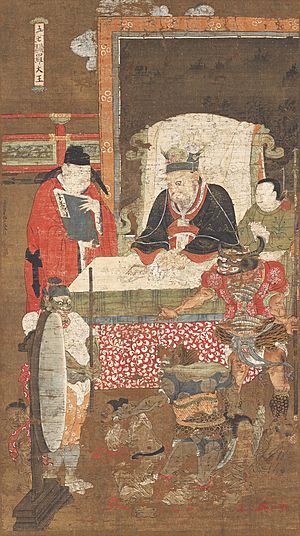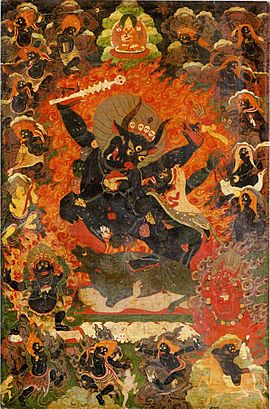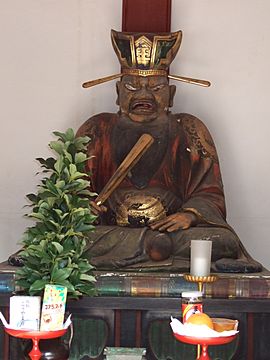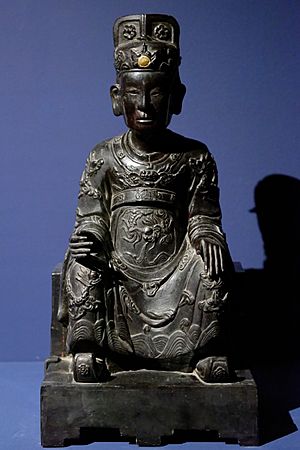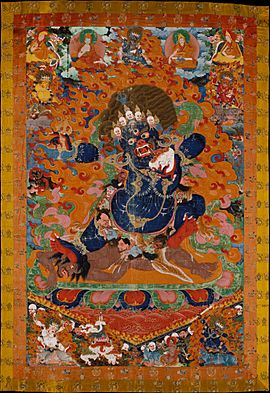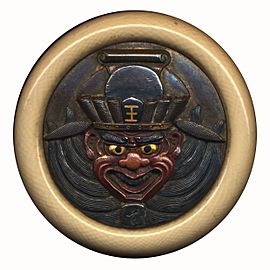Yama (Buddhism) facts for kids
In many parts of East Asia and in Buddhism, Yama or King Yan-lo is known as the King of Hell. He is a powerful god who judges people after they die. He also oversees the different hells and the cycle of saṃsāra, which is like a journey souls take through different lives.
Even though Yama started as a god in Hinduism, the Buddhist Yama has grown and changed. He has different stories and jobs than the Hindu god. He is known in many countries where Buddhism is practiced, like China, Korea, Japan, Vietnam, Thailand, and more.
Contents
Yama in Theravāda Buddhism
In Theravāda Buddhism, which is practiced in countries like Sri Lanka and Thailand, the Buddha taught about Yama. He said that if someone treated their parents, holy people, or elders badly, they would meet Yama after death.
Yama would then ask them if they thought about their bad actions. If they didn't, they would be sent to a difficult hell. They would stay there until the bad effects of their actions, called karma, were used up.
Today, in Theravāda countries, Yama is seen as someone who sends warnings to people. These warnings can be things like old age, sickness, or punishments. They are meant to encourage people to behave well. When people die, they are brought before Yama. He looks at their actions and decides where they will be reborn next. This could be back on Earth, in a heaven, or in a hell. Sometimes, people believe there are a few Yamas, each in charge of a different hell.
Yama in East Asian Cultures
In Chinese mythology, Chinese folk religion, and Taoism, King Yan is the god of death. He rules over Diyu, which is the underworld, and oversees the "Ten Kings of Hell." He is also called King Yanluo.
King Yan is often shown as a large man with a red face, big eyes, and a long beard. He wears traditional robes and a judge's hat. This hat often has the Chinese symbol for "king" on it. He is sometimes seen on Chinese "hell money," which is paper money burned as an offering to the dead.
King Yan is not just a ruler; he is also a judge. He decides what happens to all the dead souls. He always appears as a man. His helpers include a judge who writes down every soul's name and when they are supposed to die. Two scary guardians of hell, Ox-Head and Horse-Face, bring the newly dead to King Yan for judgment.
People who have done good things might be rewarded with good future lives. They might even be reborn into their old lives. But people who have done bad things will be punished or have difficult future lives. In some stories, King Yan divides Diyu into many courts, each ruled by a different king. For example, one king might be in charge of thieves and murderers.
After being judged by King Yan, spirits either enjoy a time of peace or suffer punishment in the underworld. Neither place is forever. After a while, they return to Earth in new bodies.
Sometimes, "Yan" was seen as a job in the heavens, not just one person. There were stories where an honest person on Earth was given the job of Yan. They would then serve as the judge of the underworld. Some famous judges from history, like Bao Zheng, were even said to become Yan at night or after they died.
Over time, different ideas about the number of hells and their rulers developed in China. One popular idea, influenced by Taoism, said there were ten kings. King Yanluo was the fifth of these ten kings. The other nine kings had different Taoist names. Even with other gods of the dead, King Yanluo remained the most famous.
These Chinese beliefs later spread to Korea, Japan, and Vietnam. In Japan, he is called Enma or King Enma. In Korea, he is known as Yeom-ra. In Vietnam, these gods are called Diêm La Vương or Diêm Vương. They are seen as a group of ten kings who rule the underworld.
A common saying in Japan is: "If you lie, Lord Enma will pull out your tongue." This is often told to children to encourage them to tell the truth. Another Japanese saying compares borrowing money to the calm face of Jizō (a kind god) and repaying it to the angry face of Enma. This means people might be nice when they need something but change when it's time to give back.
Changing Identity of Yanluo Wang
In Chinese folk religions, which often mix different beliefs, people have different ideas about Yanluo Wang. Some see him as a Buddhist god, while others think he is a Taoist god. He is usually seen as a strict god, but also as a fair judge in the underworld. He is also known as a supporter of good Buddhist teachings.
Yama in Tibetan Buddhism
In Tibetan Buddhism, Yama is known as Yama Dharmaraja. He is sometimes called Kalarupa or Shinje. He is seen as both a scary figure who starts the cycle of death and rebirth, and a protector of spiritual practices. In a famous image called the Bhavachakra, all parts of life are shown inside the mouth or arms of a monster-like Shinje. Shinje is sometimes shown with a partner, Chamundi, or a sister, Yami.
He is often pictured with the head of a buffalo, three round eyes, and sharp horns that look like they are on fire. He looks fierce and angry. In his right hand, he often holds a stick with a skull, and in his left, a lasso. On his head, he wears a crown made of skulls. Many pictures show him standing on a bull that is crushing a person lying down.
See also
 In Spanish: Enma para niños
In Spanish: Enma para niños
- Ghost Festival
- Bon Festival
- Diyu and Youdu
- Heibai Wuchang
- Kṣitigarbha (地藏王)
- Meng Po (孟婆)
- Naraka and Avīci
- Ox-Head and Horse-Face (牛头马面)
- Yama
- Yamantaka (Manjushri)
- Yanluo Wang
- Yomi (Japan)
- Zhong Kui (钟馗)
- Zhong Yuan Festival
- Cheng Huang Gong (城隍公)
- Heibai Wuchang (黑白无常)
- List of death deities


